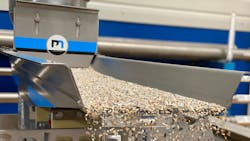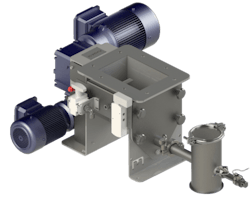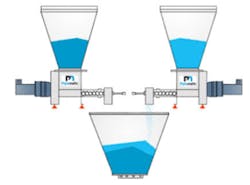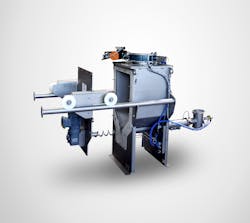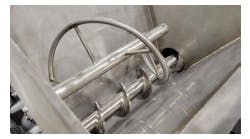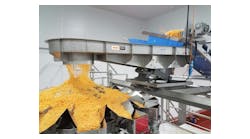Five questions to ask when selecting powder dosing equipment
With so many feeding and metering devices available in the market, it can be challenging for plant operators to know which is the right one to select for their bulk material processing application. This article provides five easy-to-answer questions to ask that will help you select the right dosing equipment.
What type of material are you dosing?
This may seem like an obvious question, but it is still an important one. Different materials can have a wide variety of characteristics. Does your material flow well, or is it cohesive and tend to stick to surfaces? Is it dusty, abrasive, friable? Vibrating feeders are a great dosing mechanism for materials that are considered friable, abrasive or both. A vibrating feeder uses an open or closed trough that shakes or vibrates to convey the material into the downstream process while keeping the material’s integrity intact. Also, there is much less wear and tear from abrasion, which extends the life of the feeder and reduces the amount of maintenance required. An adjustable feed flap allows the operator to slow down or speed up the feed rate.
Vibrating feeders are also commonly used on pellets, granular materials and capsules (Figure 1). Screw feeders are considered all-purpose metering devices and are extensively used where friability and abrasiveness are not as much of a concern. If the material has poor flow properties, screw feeders can be supplemented with mechanical agitators to stir the material and promote flow in the feeder’s storage hopper.
How accurate does your dosing need to be?
Some processes call for greater dosing accuracy into packages, storage bins, containers, etc. A high-value processed material may need to be fed accurately to prevent profit loss by packing too much or too little. A screw feeder, as shown in Figure 2, excels at providing the necessary precision to significantly minimize material overfeeding. For example, Palamatic Process offers screw feeders that, in some instances, can dose within +/- 1 gram of accuracy.
On low-value materials, however, you may be more concerned about feed rates and high-volume production on low value materials. In this instance, a butterfly valve with a positioner most likely will suffice. Using a butterfly valve with a positioner and pneumatic actuation allows the operator to have a measure of control over the flow rate of the material by adjusting the angle of the butterfly valve disc. By slowly closing off the valve, you get a degree of flow control as you approach your desired target fill weights.
Do you need to dose by volume or weight?
It is a common part of most processes for the operator to know how much material is being fed to the downstream process. The question of how much material is being fed can be followed with additional questions to fine tune which measuring method is most suitable. For example, do you have packages that are already premeasured to a specific volume? By using instruments such as level probes and sensors, you can tell the metering device to unload material until a certain level either within the feeder itself or in the container below has been reached. On the other hand, if you need to dispense material to a target weight, integrating load cells on the feeding equipment will help achieve a loss-in-weight functionality, as shown in Figure 3. Or you could use a gain-in-weight setup by putting the load cells on the station under the receiving container.
What equipment are you feeding material into?
Another very common bulk solids metering application is the introduction of material into a pneumatic conveying system. A rotary airlock valve, as shown in Figure 4, provides the ability to feed material from a bulk container above (bulk bag, sack, drum, etc.) into either a pressure or vacuum conveying system. A multi-lobed rotor spins on its axis via a direct-drive motor. As the rotor spins, material fills the empty pockets which are then exposed to the conveying system where the material evacuates and is swept away by the air conveyance. The rotor isolates the feed from the pressure or vacuum, therefore safely and effectively introducing the material into the transfer system. Rotary valves can implement variable frequency drives (VFDs) to slow down or speed up the rates at which the material is dispensed. Caution must be exercised when speeding up the rotary valve, however, because too much speed may decrease filling efficiency of the rotor pockets and defeat the purpose. Another common use for rotary valves is unloading raw materials from bulk storage equipment such as silos and bulk bags.
To isolate the material under pressure or deal with an extremely abrasive or high temperature material, dome valves with inflatable seals are a great dosing option. As the valve closes, the seal inflates trapping material against the dome. The design and functionality provide the necessary seal against pressure and minimize wear and tear on the valve itself. The Inflatek valve from Palamatic Process provides sealing and total containment at temperatures up to 350°C.
If you are simply metering powders and bulk solids into types of process equipment such as mills, screeners, mixers, etc., then most types of dosing equipment will be up to the task. Screw feeders, vibratory feeders, rotary valves all can provide the necessary metering this type of process equipment requires. With careful consideration, even screw conveyors may be able to provide the necessary rates for value-adding equipment to effectively process the material.
Does your process have strict hygienic requirements?
For hygienic applications, you may want to consider feeding and dosing equipment that is designed with the intent of minimizing downtime for cleaning and maintenance cycles. Feeding equipment is widely used in all dry process industries including mining, chemical and energy. However, the food, dairy, pharmaceutical, nutraceutical and cosmetics industries often require equipment that is made to prevent material trap points and that can be easily sanitized between production runs. For example, Palamatic Process offers a line of sanitary feeding and processing equipment called the ECD (easy clean design) range. The ECD rotary valve can be integrated with guide rails and clamping flanges, allowing the rotor to be quickly pulled out of its housing for inspection and cleaning. The ECD screw feeder, as shown in Figure 5, offers the same design concept, with the screw bearing and flights being supported by a quick-release guide track for the same benefits.
Chris Jones is sales manager for Palamatic Process in Philadelphia, PA. He has more than 8 years of experience in powder and bulk solid material handling with a background in industrial applications, including bulk filling and unloading, conveying, dosing, mixing, screening, milling and more. He be reached at [email protected]. Palamatic Process offers a full range of feeding and dosing equipment to meet any industry and material-handling process. Equipment can be offered in mild/carbon steel, 304 stainless steel or 316 stainless steel fabrication with standard bead blast or special fine grit internal finishes.
Palamatic Process
